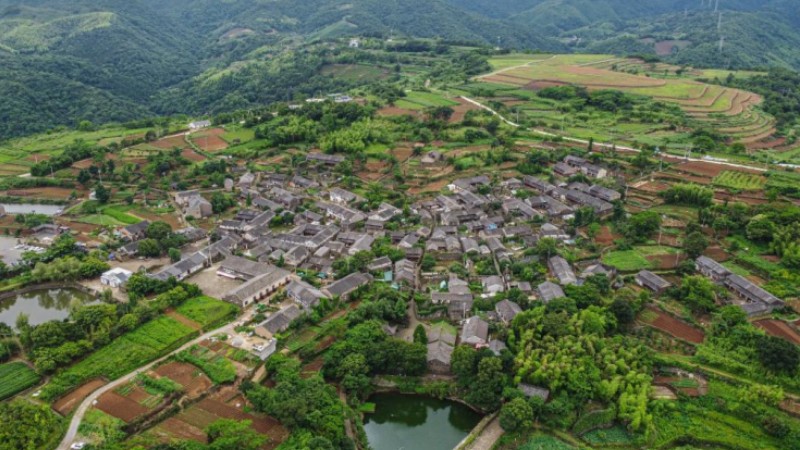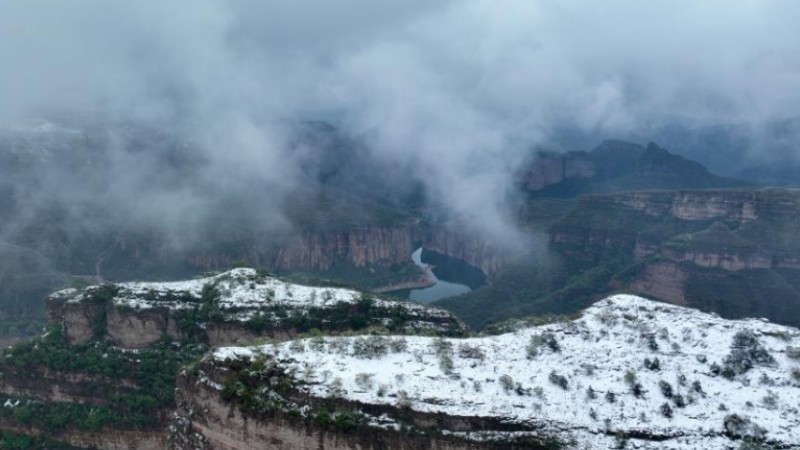What's behind Canada's unmarked graves
OTTAWA, April 30 (Xinhua) -- In late May 2021, remains of 215 Indigenous children were found in Canada, stripping away the nation's hypocritical facade and stunning the world.
Nearly two years after the 215 suspected unmarked graves of Indigenous children (the actual number was later revised to 200) were identified at the former Kamloops Indian Residential School in British Columbia, thousands of burials were continuously found at former Indian residential school sites across the country.
Recently, another 171 "plausible burials" were uncovered at the site of the former St. Mary's Indian Residential School in northern Ontario. As of January 2023, over 2,400 potential unmarked graves had been found.
As the records from many residential schools are sparse or incomplete, the actual number of Indigenous children's deaths may be far higher, which means that the facts could be more cruel than one could imagine, although the dark history of the Indian residential school system in the country is an open secret.
Experts believe that behind the "appalling" residential schools system are structures of colonialism, human rights abuses, systematic oppression and discrimination. All these are continuously challenging Canada.
CANADA "ON BACKS OF FREE LABOR"
Canadian playwright and actress Jani Lauzon thought the establishment of the residential schools was related to gaining free labor from students who went to those schools.
"Canada was created on the backs of free labor which is another reason for the residential schools. Those kids were free domestic service and free agricultural service. The agricultural industry in Canada was created and possible on the backs of students who went to those schools," said Lauzon. "That's just the tip of the iceberg in terms of the stories and the atrocities that happened."
Born as a Metis girl, Lauzon knew all about discrimination as a child. Metis are the descendants of native residents and early white settlers in North America.
"I can't say that the Metis experience is much different than the First Nations' experience, because we have mixed ancestors. I didn't grow up on reserve. I actually didn't grow up knowing very much about my indigenous ancestry at all," said Lauzon.
For centuries, Metis were targets of systematic discrimination and oppression together with First Nations and Inuit people in Canada.
"It was later on in doing a lot of work around genealogy and sitting in the Archives in Ottawa trying to find answers to these things that I felt so strongly connected to," she said.
Lauzon said what she found about how indigenous people were treated was very traumatizing.
"It still breaks my heart that there are so many people in this country who have no idea what happened, who have not educated themselves, who have not taken the time to better understand the circumstances," she said.
She wants her audience to ponder on the dark pages of Canada's history.
Over 150,000 First Nations, Metis and Inuit children were separated from their families and forced to attend government-funded schools between the 1870s and 1997.
In 2015, a Truth and Reconciliation Commission appointed by the Canadian government concluded that children were physically and sexually abused and died in the schools. While it has documented at least 4,100 deaths, the commission said the real numbers may never be fully known.
STRUCTURES OF COLONIALISM
Dr. Tricia Logan, the interim academic director of the Indian Residential School History and Dialogue Centre at the University of British Columbia, stressed that for over 100 years and until even now, native residents including First Nations, Inuit and Metis face systematic oppression and discrimination, and Indian residential schools are just a part of that colonial system.
Survivors, their families and communities constantly require Indian hospitals, day schools, day scholars, and other kinds of institutions that were very closely affiliated with residential schools to be included in the research, especially where it involves student diseases, deaths and abuses, she said.
"We are trying to look at residential schools and the history of them in a much broader scope for all of Canada," said Dr. Logan, adding that they are also investigating how colonialism and its structures, like residential schools, child welfare system, Indian hospitals, day schools, were related to missing and murdered indigenous women and girls, and "how the effects and the ongoing impacts of colonialism carry on today."
The residential schools are not isolated or a system on their own, but well connected to other structures of colonialism, like day schools and Indian hospitals, and today's child welfare system, she added.
Dr. Logan worried that many relevant documents are still unavailable to researchers and First Nations, as many historical records are decaying rapidly and need to be digitized as soon as possible.
"There's a great deal of urgency" because researchers need to align the investigations and the work of individual communities, ground-penetrating radar research, archaeological research and community- and survivor-led research, she said. "That level of urgency is to match the records with each one of those different sites and investigations."
They also need to assure digitization and proper care of the records and see how to make them accessible to the communities depending on levels of privacy and restrictions, she added.
MORE INTERNATIONAL ATTENTION NEEDED
Kisha Supernant, director of the Institute of Prairie and Indigenous Archaeology at the University of Alberta, said the international community should continue to keep an eye on the Indian residential school investigation.
"To have the ugly history of Canada shared across the globe has spurred more action on this issue than if the news had primarily been focused on nationally. It has also led to an increase in the pace of investigations," said Supernant, who was appointed to the National Advisory Committee on Missing Children and Unmarked Graves.
Supernant said that the rise in reporting of investigations for unmarked graves is due to several factors.
"First, many of the announcements since May 2021 are the result of years of work undertaken by the First Nations that they had not previously made public. For example, investigations had been underway at the Brandon Industrial School in Manitoba since 2012 and at the Kuper Island Residential School in British Columbia since 2014," said the scholar.
"Second, many Indigenous communities had wanted to undertake this work but lacked access to funding to conduct the investigations. Funding is now available, so many are beginning their searches now," she said.
"Finally, there is a lot more public awareness and support for the First Nations in this difficult work, so the announcements of unmarked graves receive a lot of media attention," Supernant added.
Supernant called for more support to the First Nations.
"There are challenges they face in terms of access to records, training in the various techniques, and management and safeguarding of data," she said.
She believed that the legacy of residential schools and the genocide against Indigenous peoples are at the root of so many challenges that Indigenous peoples face, as the trauma of genocide continues to impact their communities.
"There is also enduring structural racism in Canadian society, from the justice system to health care to education. All of this needs to be addressed in order for Indigenous communities to have healthy, vibrant futures," she said.
MANY HUMAN RIGHTS VIOLATIONS
Cali Tzay, UN Special Rapporteur on the rights of Indigenous Peoples, said at the end of a 10-day official visit to Canada last month that the testimonies of survivors of Canada's residential school system were appalling and that many existing challenges remain unaddressed in this country, including business decision-making without Indigenous Peoples.
Tzay cited the Coastal GasLink Pipeline and the Trans Mountain Pipeline projects to illustrate how activities of business corporations further contribute to human rights violations and abuses of Indigenous Peoples in provinces across Canada, including the criminalisation of human rights defenders.
"In many cases projects are developed without engaging in good faith consultations with Indigenous Peoples whose rights and interests are impacted, and without their consent," the UN expert said.
"International human rights law entails a duty on the part of the State not only to refrain from violating human rights, but to exercise due diligence to prevent and protect individuals from abuse committed by non-State actors, such as business enterprises, including outside their territories," he said.
Tzay said intergenerational trauma caused by residential schools and structural racial discrimination have led to a number of present-day human rights violations and abuses, including the current crisis concerning missing and murdered Indigenous women and girls. It is estimated that Indigenous women and girls are 12 times more likely to be murdered or go missing than other women in Canada.
The special rapporteur also expressed concern that Indigenous peoples have continued to be overrepresented in the criminal justice system.
"The situation of Indigenous women and gender diverse peoples is even more devastating as they represent half of the federal prison population," Tzay said. "Indigenous peoples are often victims of racial profiling, arbitrary and discriminatory arrests, and disproportionate use of force by law enforcement personnel."
"The negative legacies of residential schools are also reflected in the child welfare system today. Despite comprising 7.7 percent of the Canadian population, over 53 percent of children in care are indigenous, up to 90 percent in some provinces," he said.
The final full report on the rights of Indigenous peoples is expected to come out in September.
Photos
Related Stories
- Canada provides new military aid package for Ukraine
- Canada's privacy watchdog opens investigation into OpenAI, ChatGPT over complaints: Canadian media
- Canada's employment continues upward trend in March
- Canada to raise federal minimum wage to keep pace with inflation
- Two police officers killed on duty in Canada
Copyright © 2023 People's Daily Online. All Rights Reserved.









